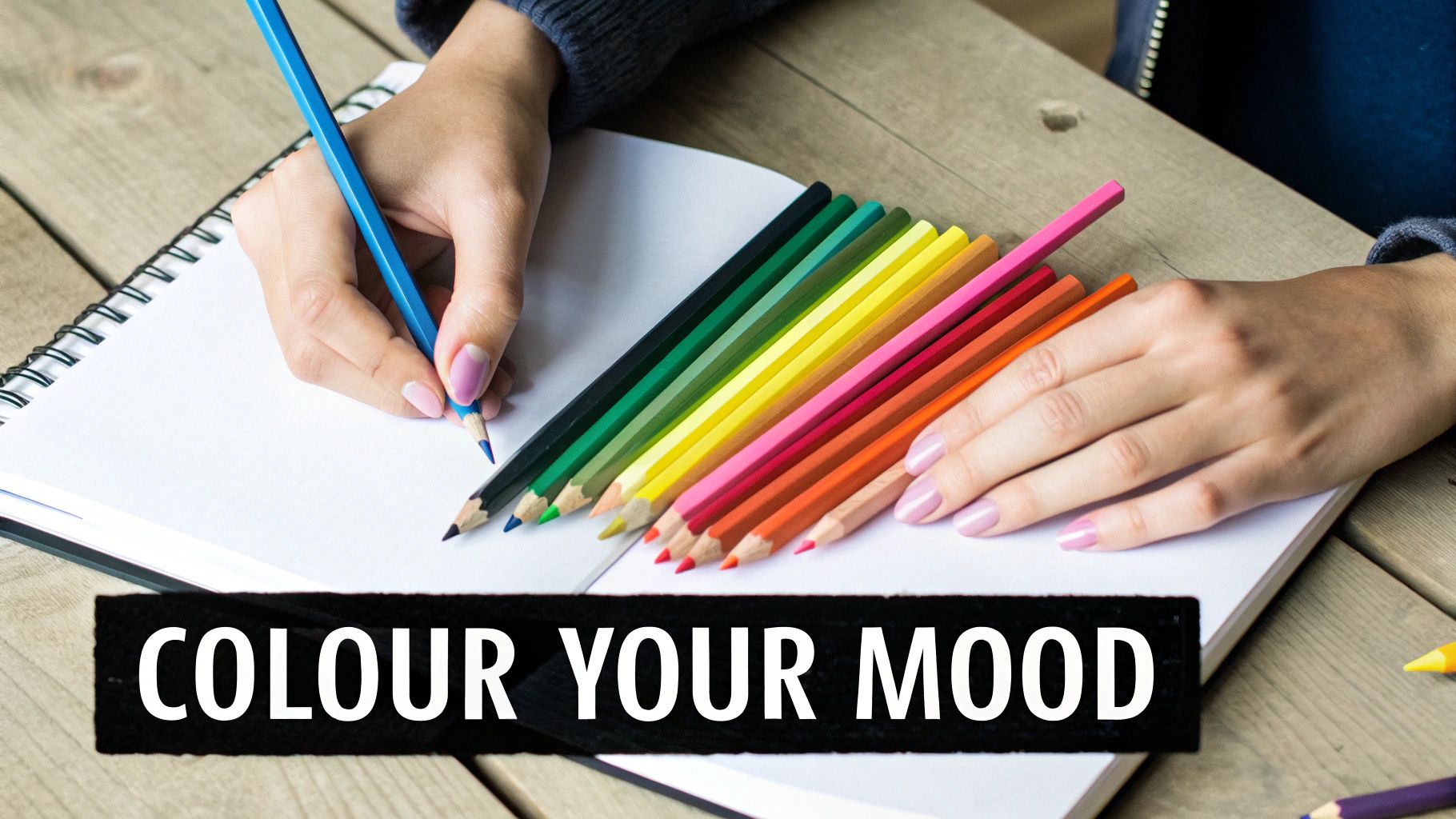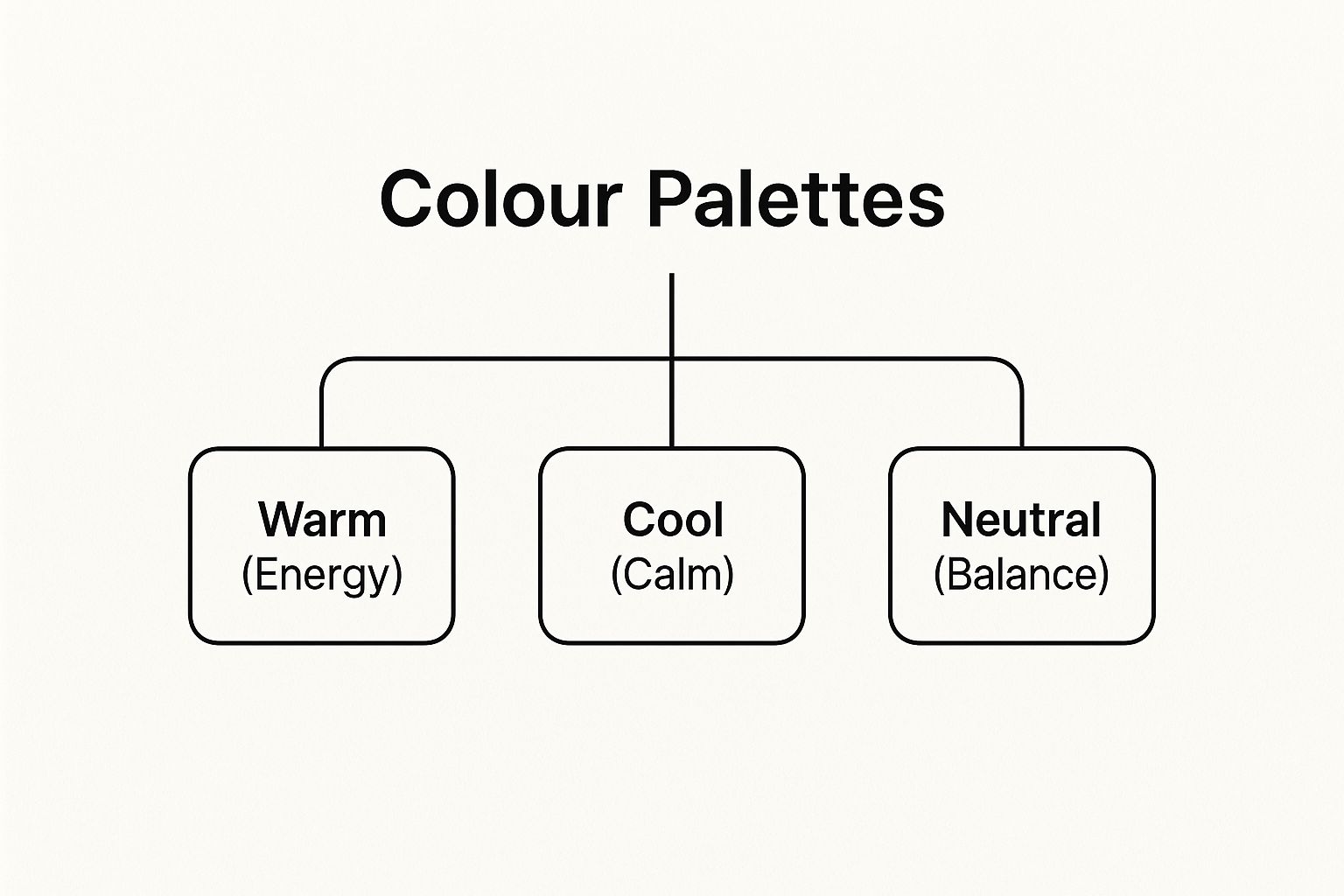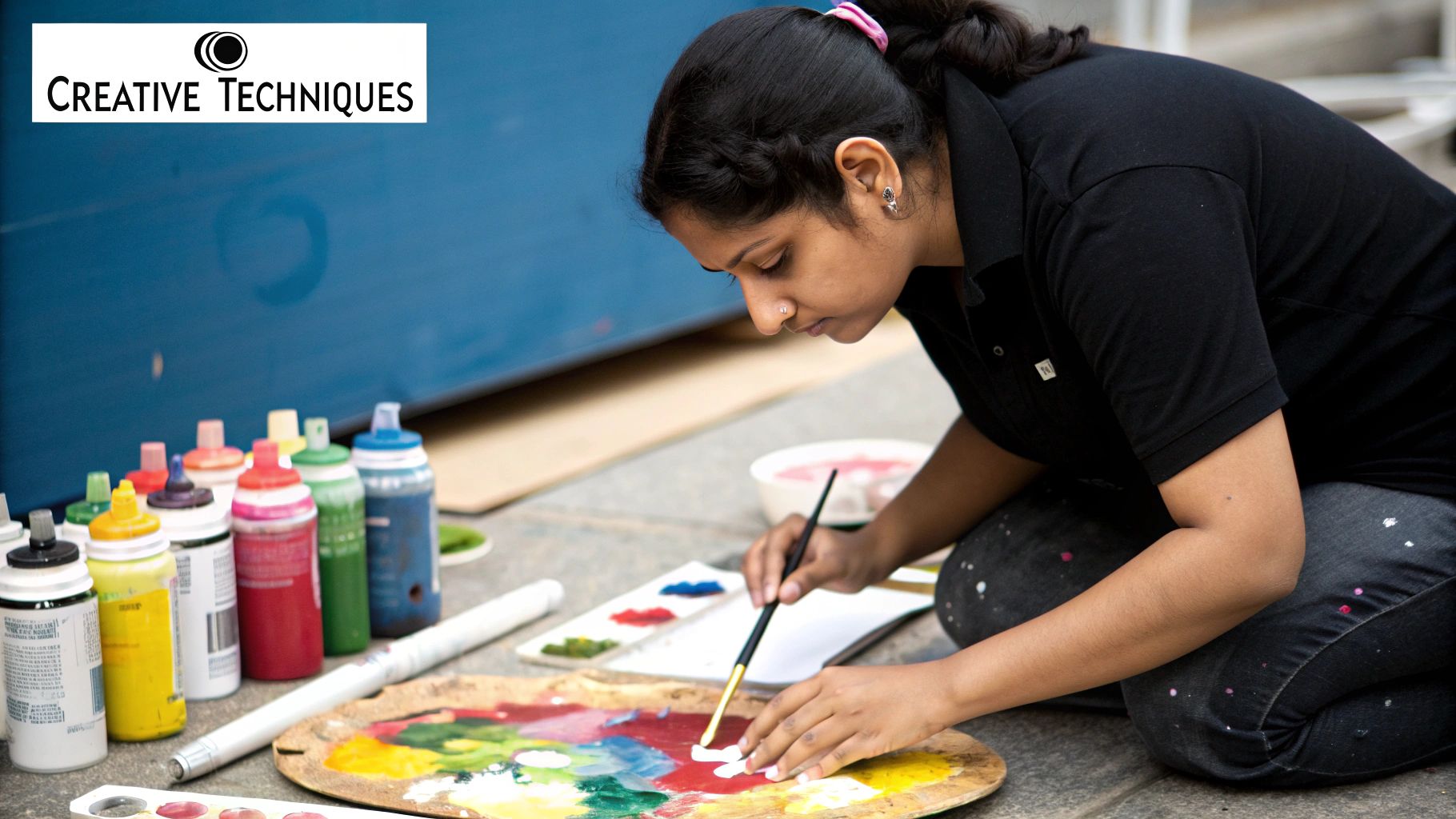
Colouring Emotions to Support Your Child
Share
Sometimes, a child’s big emotions can feel overwhelming, both for them and for us. The technique of colouring emotions acts as a bridge, connecting their turbulent inner world to the outside. It’s a simple, creative tool that gives feelings a shape and a colour, making them less scary and much easier to talk about.
Think of it as giving your child a language for their feelings. Instead of being lost in a confusing storm of 'sad' or 'angry', they can start to say, 'I'm feeling very dark blue today.' This turns an abstract feeling into something tangible they can see, hold, and discuss—a gentle starting point for vital conversations about mental health.

This creative practice is so much more than just an art project; it’s a foundational tool for building emotional resilience. When children assign colours to their feelings, they begin to understand that emotions are a normal, manageable, and temporary part of being human. This is especially important today. In the UK, one in six children aged 5-16 are identified as having a probable mental health problem, highlighting the need for early support.
The Power of Naming a Feeling
Giving an emotion a name—or in this case, a colour—is the very first step towards managing it. The process is incredibly powerful. It helps children to:
- Identify and Acknowledge: They learn to recognise what they are feeling instead of just being swept away by it. For example, instead of a tantrum, they might grab a red crayon and furiously scribble, showing you their anger.
- Communicate Effectively: It gives them a simple, low-pressure way to express complex feelings they might not have the words for yet. A child might colour a grey cloud to show they feel sad about a friend moving away.
- Develop Coping Skills: It opens the door to discussing healthy ways to handle difficult emotions. For anyone exploring methods to enhance emotional control, discovering effective emotional regulation strategies can be a game-changer.
It's important to remember that I am not a mental health professional. This guidance is based on experience and research, but if you have serious concerns about your child's mental health, please seek advice from your GP or a qualified professional.
Ultimately, colouring emotions equips children with a lifelong skill. It helps them build a strong foundation for mental wellbeing, giving them a creative outlet and a safe way to explore their inner landscape.
Why Connecting Colour and Feelings Matters
This creative practice isn't just about making pretty pictures; it’s about laying down a foundational skill for life. When a child learns to connect 'red' with anger or 'yellow' with happiness through colouring emotions, they are practising the vital skill of emotional identification. It’s a simple process that turns abstract, confusing feelings into something tangible they can see, talk about, and eventually, learn to manage.
This teaches them that all feelings, even the uncomfortable ones like sadness or frustration, are valid and they don't last forever. Given the importance of addressing mental health from a young age, nurturing this kind of emotional literacy is a crucial step in building resilience against future challenges.
The mindful, calming nature of colouring also provides a natural stress-reducer. It helps to soothe an anxious mind, offering a healthy coping mechanism that supports their social-emotional development, both at school and at home.
The Psychology of Colour and Emotion
The powerful link between colours and our feelings isn't a new idea. The study of colour psychology goes as far back as Ancient Egyptian times. Here in the UK today, academics continue to explore how different hues influence our wellbeing, behaviour, and how we see the world. Research has shown that we consciously use colour to shape our environments, which in turn has a big impact on how we feel and act. You can read more about these fascinating findings on colour's impact on wellbeing.
This deep connection is exactly why colouring emotions is so effective. It taps into an almost instinctual part of our brains that already associates certain shades with specific emotional states, making feelings much easier to get to grips with.
This technique helps a child build a personal dictionary of feelings, using colours as their very first words. For example:
- Blue might mean calm, like a quiet sea.
- Grey could represent a sad day filled with clouds.
- Bright orange might be the colour of excitement for a birthday party.
By giving them this tool, you’re doing so much more than just distracting them with an activity; you’re equipping them with a language to confidently navigate their own inner world.
Getting Started with Colouring Emotions at Home
Ready to give colouring emotions a try? The brilliant thing is, you don't need any special kit. Just grab some paper and whatever your child loves to use—crayons, felt tips, or even paints will do the trick. The most important thing here is to create a space that feels relaxed and exploratory. This isn’t a test; it’s about connection, not perfection.
A great way to start is with gentle, open-ended questions. You could try asking, 'If your happiness had a colour today, what would it be?' or perhaps, 'Can we draw what that frustration in your tummy looks like?' It’s their personal connection to a colour that truly matters, so let their imagination lead the way.
To help you get the ball rolling, we've put together a little guide on common associations, but always remember there are no right or wrong answers in this creative process.
A Starter Guide to Emotion-Colour Associations
Use this as a gentle starting point, but always encourage your child to choose the colours that feel right for them. There are no wrong answers.
| Emotion | Commonly Associated Colour | Conversation Starter |
|---|---|---|
| Happy | Yellow, Orange | "What does this happy colour make you think of?" |
| Sad | Blue, Grey | "Tell me about this blue feeling. Where do you feel it?" |
| Angry | Red, Black | "This red looks very powerful. What is it telling us?" |
| Calm | Green, Light Blue | "What does this calm colour feel like in your body?" |
| Scared | Purple, Dark Grey | "It's okay to feel scared. Can we draw it together?" |
This table is just a springboard for conversation. The real magic happens when you listen to your child’s own unique interpretations and give them the space to express what each feeling means to them.

This simple visual helps show how warm colours can represent big energy, while cooler colours often bring a sense of calm. It's a handy way to think about how different shades can carry different emotional weights.
If you’re looking for more structured ways to begin, a printable 'feelings wheel' can be a fantastic tool, or you could read a book like 'The Colour Monster' to introduce the concept in a really fun, engaging way.
To start your journey, you can explore various colouring activities that can serve as a wonderful canvas for emotional expression. For some brilliant, ready-to-go resources, you can also download these free emotions colouring sheets and get started right away.
The Science Behind Why This Method Works
Ever wondered why this simple activity feels so right? It’s not just a hunch; there's some fascinating science behind it. Our brains are naturally wired to create powerful links between colours and feelings. The whole idea of colouring emotions simply taps into these deep-seated connections.
This isn't about setting strict rules, like 'sad is always blue'. Instead, it’s about using colour psychology to give your child a concrete way to process and show you what’s going on inside their head.

It’s more than just an intuitive idea—it’s a real, evidence-based tool for parents and educators. Research from various UK institutions has shown again and again how different hues can subtly shift our mood and even how well we perform tasks.
Colour as a Psychological Tool
Studies by UK-affiliated psychologists have actually measured how certain colours can adjust our cognitive and emotional states. In one clever experiment, the colour blue was found to significantly boost creativity by putting people in an exploratory mindset. On the other hand, red triggered a more cautious mode, which improved performance on tasks that required sharp attention to detail.
This powerful connection is why specific shades work so well as emotional shortcuts for children:
- Blue: Often makes us think of calm and creativity. It's no wonder it’s a go-to colour for relaxing spaces.
- Red: Can spark feelings of alertness and energy, making it the colour of passion, excitement, or even anger.
- Yellow: Is almost universally linked with happiness, optimism, and warmth, just like sunshine.
By linking a feeling to a colour, you help your child make sense of complex emotions. The act itself is a form of mindfulness, providing a quiet moment for reflection and self-soothing.
Ultimately, you’re helping them build a visual language for their feelings, which is a massive step towards emotional literacy. We explore this practical approach in more detail in our article on the power of emotions and colouring sheets.
Turning Drawings into Deeper Conversations
The act of colouring in an emotion is just the first step; the real magic happens in the chat that comes after. When your child shows you their "grey and stormy" picture, it’s a precious invitation to connect and understand what's really going on inside their head.
Let their drawing be a gentle prompt to explore what’s behind the feeling. You could try asking something like, "Tell me a bit more about this stormy feeling. What happened today to make it show up?" This is a golden opportunity to really listen, making it clear that their feelings are valid, no matter what they are.
Building a Safe Space to Talk
Creating an environment where talking about mental health feels as normal as talking about a scraped knee is so important. Sadly, mental health problems cost UK businesses up to £56 billion a year, often stemming from issues that took root when people were young. By normalising these chats early on, you build a foundation of trust that can last a lifetime.
It's also the perfect moment to introduce some simple, healthy ways to cope. After talking through their stormy picture, you might suggest a few things they can do next time that feeling visits:
- Taking three slow, deep "balloon breaths."
- Finding a quiet, cosy corner for a few minutes to themselves.
- Giving a favourite teddy a great big squeeze.
Just a quick note: I'm not a mental health professional. This is all just friendly advice, but if you're ever worried about persistent feelings of sadness or anxiety in your child, it's always best to get help from your GP or a qualified professional.
Extending the Conversation
You can keep these positive conversations going with other supportive tools. Many families find that mental health books for children are a brilliant way to reinforce these ideas. You can even find some great mental health apparel with positive messages, which act as gentle, wearable reminders to be kind to our minds.
For more ideas on how to nurture these important discussions, have a look at our guide on teaching kids about feelings. At the end of the day, turning a simple drawing into a heartfelt conversation is a powerful step towards building a truly resilient child.
Got Questions About Colouring Emotions? You're Not Alone.
Starting something new like colouring emotions is bound to bring up a few questions. That’s completely normal! In fact, it shows you’re really thinking about your child’s emotional world, which is a wonderful thing. Let's walk through some common queries to help you feel confident as you get started.
It's no secret that many parents worry about the impact of social media on their kids' mental health. Offering simple, offline activities like colouring is a brilliant way to build resilience and give them a space for self-expression, far away from the pressures of a screen.
Common Questions from Parents
What if my child doesn’t want to talk about their drawings?
That's perfectly okay. The goal here is to provide an outlet, not to force a deep and meaningful conversation every single time. The act of colouring itself is therapeutic; it helps them process feelings without ever needing to find the right words.
Just sitting with them quietly while they create is a powerful way to show your unconditional support. Let them know you're always there to listen if and when they feel ready. By getting the feeling out onto paper, they’ve already taken a huge, positive step.
My child only uses dark colours like black. Should I be worried?
Not necessarily. It's easy to jump to conclusions, but context is everything. While colours like black or grey can sometimes point to sadness, they can just as easily represent strength, boldness, or even a sense of comfort for a child.
Instead of worrying, you could try a gentle, curious question like, 'That's a very powerful colour. What made you choose it today?'
If the consistent use of dark colours is paired with other changes you've noticed (like in their sleep, appetite, or general behaviour), then it might be worth exploring further with a professional.
A Quick Note: I'm passionate about children's wellbeing, but I am not a mental health professional. This advice is just for guidance. If you have serious or ongoing worries about your child's mental health, please reach out to your GP or another qualified professional for help.
Practical Tips for All Ages
What age is best to start colouring emotions?
You can start as soon as your child can comfortably hold a crayon, which is usually around two or three years old. For toddlers, keep it really simple. Focus on the big, basic emotions like 'happy', 'sad', and 'angry'.
As they grow and their own emotional world becomes more complex, you can introduce more nuanced feelings like 'frustrated', 'proud', and 'lonely'. The key is to match the complexity to their stage of development.
Are there other tools that can support this activity?
Absolutely. Think of colouring emotions as one fantastic tool in your toolbox. Combining it with other resources can create a really supportive environment for your child’s emotional growth.
- Mental Health Books: Reading stories designed to talk about feelings, like "The Colour Monster" or "Ruby's Worry", helps normalise these conversations and makes them feel less scary.
- Mental Health Apparel: Sometimes a t-shirt or hoodie with a positive message like 'It's Okay to Feel' can act as a gentle, everyday reminder for your child to be kind to their mind.
- Relaxation Tips: Why not try pairing colouring time with some simple relaxation tips? Deep breathing (smell the flower, blow out the candle) or a gentle hand massage can create a powerful little routine for calming down.
By weaving these tools together, you're not just doing an activity; you're building a strong and lasting foundation for your child’s emotional wellbeing.
At Little Fish Books, we create beautiful books and resources to help you and your child navigate big feelings together. Explore our collection of emotion-focused stories and activities to support your colouring emotions journey. Discover our full range at https://thatsokay.co.uk.
